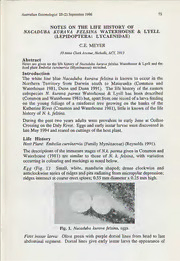
Notes on the life history of Nacaduba kurava felsina Waterhouse and Lyell (Lepidoptera: Lycaenidae) PDF
Preview Notes on the life history of Nacaduba kurava felsina Waterhouse and Lyell (Lepidoptera: Lycaenidae)
Australian Entomologist 23 (2) September 1996 73 NOTES ON THE LIFE HISTORY OF NACADUBA KURAVA FELSINA WATERHOUSE & LYELL (LEPIDOPTERA: LYCAENIDAE) C.E. MEYER 10 Anne Clark Avenue, Nicholls, ACT, 2913 Abstract Notes are given on the life history of Nacaduba kurava felsina Waterhouse & Lyell and the food plant Embelia curvinervia (Myrsinaceae) recorded. Introduction The white line blue Nacaduba kurava felsina is known to occur in the Northern Territory from Darwin south to Mataranka (Common and Waterhouse 1981, Dunn and Dunn 1991). The life history of the eastern subspecies N. kurava parma Waterhouse & Lyell has been described (Common and Waterhouse 1981) but, apart from one record of a larva feeding on the young foliage of a rainforest tree growing on the banks of the Katherine River (Common and Waterhouse 1981), little is known of the life history of N. k. felsina. During the past two years adults were prevalent in early June at Oolloo Crossing on the Daly River. Eggs and early instar larvae were discovered in late May 1994 and reared on cuttings of the host plant. Life History Host Plant: Embelia curvinervia (Family Myrsinaceae) (Reynolds 1991). The descriptions of the immature stages of N.k. parma given in Common and Waterhouse (1981) are similar to those of N. k. felsina, with variation occurring in colouring and markings as noted below. Egg (Fig. 1): Small, white, mandarin shaped; dense clockwise and anticlockwise series of ridges and pits radiating from micropylar depression; ridges intersect at coarse erect spines; 0.55 mm diameter x 0.25 mm high. Fig. 1. Nacaduba kurava felsina, eggs. First instar larva: Olive green with purple dorsal lines from head to last abdominal segment. Dorsal lines give early instar larva the appearance of 74 Australian Entomologist 23 (2) September 1996 being purple but on closer examination base colouring can be seen. Head pale brown. Final instar larva: Olive green or purple, strongly humped above and prominently segmented with purple middorsal and subdorsal lines; head pale brown. Size 9-12 mm (n=40). Pupa: Covered with very short erect hairs and black spots; head and thorax brown with pinkish brown abdomen; black spotted middorsal line present from head to mesothorax; first abdominal segment with two conspicuous dorsolateral black spots; attached by anal hooks and central girdle. Average size 9 mm x 3.5 mm. Discussion The host plant is known from several sites in the Northern Territory and near the Claudie River, Cape York Peninsula (Reynolds 1991). In the Northern Territory it and associated butterfly colonies have been found at Oolloo Crossing on the Daly River, the Adelaide River bridge on the Daly River road and at the Marrakai Road jungle, 50 km south of Darwin. The host plant is a rambling woody vine which appears to grow near permanent water. Eggs generally are laid singly on new growth or flowers of the host plant. Larvae at first were collected from new growth of the host plant in late May and from the flowers a fortnight later. Larvae appeared to prefer flowers but these are short-lived. During this period larval growth is rapid, reaching final instar in 11 to 14 days. Pupal duration was 6 to 11 days. Larvae occur throughout the year but are more numerous from May to July, indicating a preference for the dry season (winter). Their appearance at other times depends upon the presence of new growth or flowers on the host plant. Adult females flutter around the host plant and rest on twigs or branches of the vine. Adult males are territorial, settling head downwards on twigs or small branches higher up in the canopy adjacent to the host plant. Acknowledgments I thank Ian Cowie of the Northern Territory Herbarium, Palmerston for identifying the food plant, Dave Wilson for his company and assistance in the field in May 1994 and Richard Weir for the egg photography. References COMMON, I.F.B. and WATERHOUSE, D.F. 1981. Butterflies of Australia. Pp xiv + 682. Angus and Robertson, Sydney. DUNN, K.L. and DUNN, L.E. 1991 Review of Australian Butterflies: distribution, life history and taxonomy. Part 3. Family Lycaenidae. Pp iii + 336-512. Privately published by the authors, Melbourne. REYNOLDS, S.T. 1991 The Genus Embelia N. Burman (Myrsinaceae) in Australia. Austrobaileya 3(3): 361-367.
